November 16, 2016
The Massive Growth of Visual Content
Supply and demand; the mechanism upon which the world of business is based. As we have seen time and time again, those who can produce what the customer wants, when and where they want it, are those who become successful in the market.
It doesn’t matter which industry you operate in, or in which field your area of expertise lies. This is the case across the board and visual content is no exception. The public appetite for this kind of content is still huge, so make sure your organization is positioned at the forefront of this wave.
The Social Media Microcosm
Social media has always been a handy barometer for the success of a piece of content. Social platforms are designed for sharing and for disseminating content, and they are easy to analyze, providing us with a wealth of useful data which shows us what is working and what is not.
And, it seems, visual content is still well and truly working. BufferApp recently released figures which put visual content as forty times more likely to garner a social media share than non-visual content, which is an astonishing figure whichever way you look at it. A similar Buzzsumo report also showed that articles with at least one image per 75-100 words achieved twice as many shares and twice as much social media interaction than one with fewer images.
These figures are backed up by other sources. For example, Kissmetrics released analytics which showed that tweets with images were far more successful than those without, receiving up to 150% more retweets. Meanwhile, Facebook released data (published again by Buzzsumo) to show that posts with images receive 2.3 times more engagement than those without. Visual content is thriving on social media platforms.
Should we really be surprised, though? After all, social media platforms tend to be highly visual mediums. Photo-sharing hub Instagram, for example, hit 400 million members in 2015, and is still growing. The demand for social visual content is always going to be big; to understand how this applies to our content and visual strategies, we need to look deeper.
Applying Science to Visual Content
All the numbers point towards an ongoing success story for visual content. In a world in which an omni-channel approach is prized increasingly highly, engagement must be measured across a variety of channels. Does visual content stand up to this level of scrutiny? It certainly seems to.
Whichever way we look at it – whether via social media, outbound email marketing, guest blog networking, or native content hosting – visual content outperforms its less visually striking counterparts time and time again. There is no secret here; we need to integrate visual content into our marketing strategies if we are to secure success.
But why is this? The reason has much to do with the science of the human mind and its psychological reaction to visual content. It has long been established that humans respond well to colored imagery. This translates well to content production, with surveyed users stating that they are 80% more likely to access a piece of content if it includes a colored image. However, the science goes deeper than this.
Shares and clicks are instant responses to great content, but as producers and visualizers we want our work to have a deeper impact than this. To achieve this, we need to create memorable content which provides a benefit long after it has been consumed. This, in turn, requires an understanding of memory.
Memory requires visual clues, giving our brains a handy reference point to use when filing information away. Tell someone a series of facts out of context and with no such visual cue, and the average individual will remember only 10% of these facts three days later. Pair these facts with an appropriate image, and levels of retention rise to 65%. At a stroke, the content has become more effective.
Different Visuals/Different Engagement
So, there is science to back up the visual content phenomenon, but what about different kinds of visual content? Most visual content and data visualization can be divided into three main components: images (including graphs, charts and tables), video content, and infographics.
Software producers Adobe spoke to a wide range of marketing professionals from across the globe. They found that over half of these professionals cited video content as the visual with the greatest return on investment, while research from Syndacast found that click-through rates on marketing emails are boosted by 65% simply by having the word ‘video’ in the subject line.
We’ve already discussed images and their power in helping our content users to remember the insight and information we deliver to them, but it is worth noting yet another piece of supporting research. This time the research was conducted by Kissmetrics, who found that relevant images shared alongside textual content increases view rates by 94%; a solid piece of data which helps to explain the ever-expanding demand.
Finally, infographics; these handy pieces of data visualization are abundant on the web and, what’s more, they have been found to work. In 2010, the Nielsen Norman Group published a study which showed users spend far more time looking at images than reading text and consuming other sources of information; a fact which illustrates the power of the infographic. Meanwhile, Massplanner found that social media like and share rates for infographic content are 200% higher than for other content forms.
High Content Levels/Low Cost
As we can see, demand remains high and it continues to grow. This means that, rather than stripping back their content production efforts and focussing on other areas, we should be aiming to streamline content processes, reducing costs and bolstering ROI.
This does not mean reducing content value, but rather becoming more savvy about what sort of content we share, how we produce it, and the costs associated with the entire process. Budget-consciousness should already be a major part of your content strategy, so aim to take this to the next level.
Offsetting the heavy lifting of content creation by deploying the right kinds of visual is not only a labor and cost-saving exercise; it is a way to directly augment the benefit you receive from content. Make sure that you are not missing out.
This is a syndicated post, which originally appeared at Visual Matters. View original post.
Source: Visual Storytelling
October 31, 2016
Insights from Visual Storytelling Summit 2016
It was our first Summit in partnership with The Idea Center at Miami-Dade College, dedicated to a topic that is mostly discussed in the context of entertainment and photography. Yes, there have been some discussions about visual storytelling in the context of marketing, but they tend to revolve around how to run an effective Instagram campaign or just covering general guidelines of making your message more human, authentic and visually pleasing.
How our event was different?
Us, at the Visual Storytelling Institute, the Summit organizer, see things a bit different. We recognize that the communication landscape is currently marked by two opposing forces; on one hand, a staggering explosion in content (4.6B content pieces are produced daily according to LinkedIn) and decreasing attention spans (close to zero per University of Miami Professor, Milica Mormann and Summit speaker), on the other. This conflict leaves businesses struggling to get their voices heard, and, in our opinion, this serves as the primary call for adventure for visual storytelling. Why? Our brain is wired to process visual content much faster than text and also to respond better to information packaged as stories vs. facts and stats. As such, we find the convergence of a structured storytelling and visual media as a platform for a whole new ecosystem that demands a new type of visual literacy.
With this premise in mind, we developed our Summit programming strategy to reflect diverse voices that can shed light on this new ecosystem and how marketers and entrepreneurs can take advantage to grow their companies.
Here are some top insights from our speakers:
We opened the day with an introduction from Lenardo Finol, Executive Director at The Idea Center, Miami-Dade College – one of the hottest innovation hubs in Miami – that hosted our Summit.
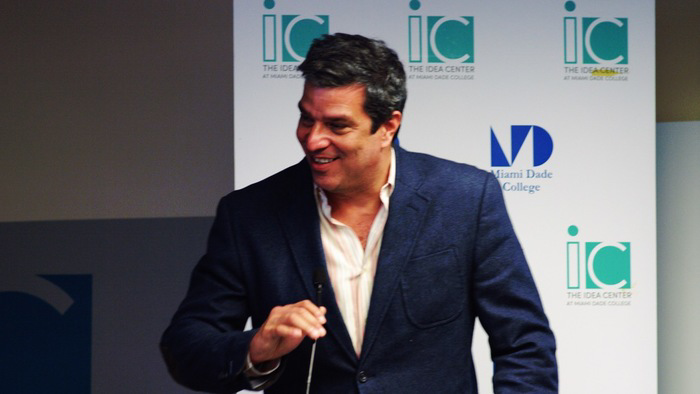
Lenardo Finol, Executive Director at The Idea Center, Miami-Dade College
(photo by Ville Ailio)
In line with the The Idea Center’s mission of helping entrepreneurs bring their ideas to life, we are excited to host the Visual Storytelling Summit 2016 in partnership with VSI.”
– Lenardo Finol, Executive Director at The Idea Center, Miami-Dade College
For context, Miami-Dade College is the second largest university in the country, boasting 160,000 students. Leandro reviewed an impressive roster of programs The Idea Center has rolled out since its inception two years ago an impressive roster of programs; from Design Thinking, Lean Startup, Codepro, Digital Marketing to VSI’s upcoming 12-week Visual Storytelling workshop starting January 2017.
Every company is a Storytelling Company
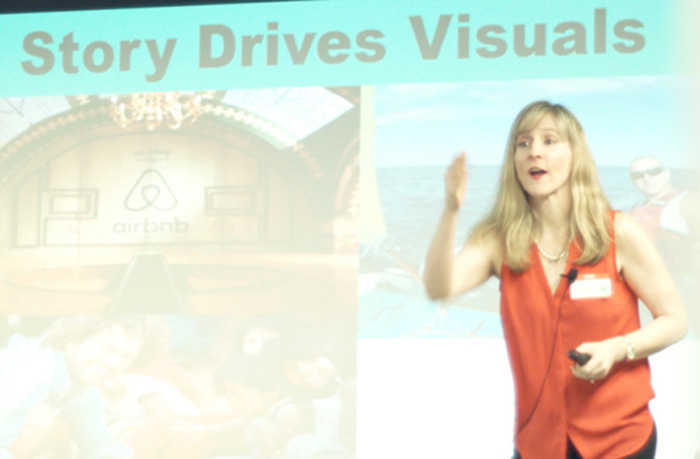
Kathy Klotz-Guest, Founder, Keeping it Human (photo by Ville Ailio)
When you tear down 4th wall and engage with people, you make magic.”
– Kathy Klotz-Guest, Founder, Keeping it Human
Kathy, our keynote speaker, effectively illustrated all the primary drivers for a compelling business storytelling while underscoring the importance of first defining your business story and then your visual strategy. The simplicity of her message coupled with creative interactive drills – totally engaged our audience. It was as if she said: “Hey, don’t just take my word for it, try it yourself.” The co-creation drill where paired attendees were asked to share their individual passions into a new idea – was a fantastic example of putting the audience in the driving seat of the experience, and demonstrating their innate storytelling power. We all learned a lot!
The Role of Attention in Visual Marketing
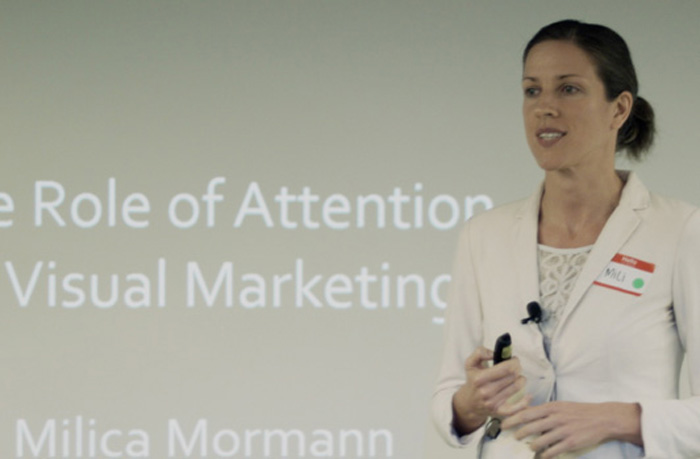 Milica Mormann, Visual Marketing Researcher, University of Miami (photo by Ville Ailio)
Milica Mormann, Visual Marketing Researcher, University of Miami (photo by Ville Ailio)
“The science of visual storytelling: Of 11M bits of info we receive per second, 10M are visual. How many bits do we process? Only 40!”
– Milica Mormann, Visual Marketing Researcher, University of Miami
Milica offered a unique perspective about visual storytelling by sharing a fascinating scientific evidence to the role of attention in driving decision making; from a glance, gaze to engage. The information was in perfect alignment with the audience expectations. It had a ton of practical intelligence like attention span is actually zero vs. 8 seconds as that overused goldfish stat has been claiming. I especially liked the fact about the importance of pre-existing interest beyond visuals – to drive attention. This would mean, that if you’re shopping for new bicycles – you’ll most likely notice bicycles everywhere you go (AKA search salience) vs. someone with a zero interest.
The Role of Authenticity in Video Storytelling
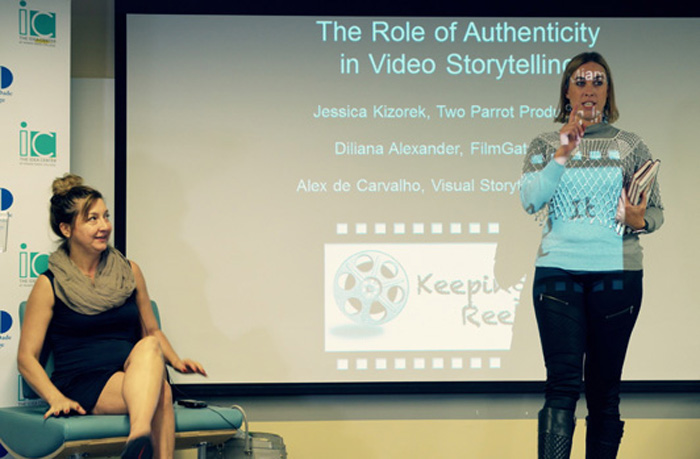 Jessica Kizorek, Partner, Two Parrot Productions &
Jessica Kizorek, Partner, Two Parrot Productions &
Diliana Alexander, Executive Director, FilmGate Miami (photo by Ville Ailio)
Use video to make viewers feel like they know you before they even meet you in person.”
–Jessica Kizorek, Partner, Two Parrot Productions
Nothing has been invented since Shakespeare. How would you tell your story in a new way?”
– Diliana Alexander, Executive Director, FilmGate Miami
Authenticity is a loaded topic that most business leaders still don’t know how to handle. With the high accessibility of creating videos on-the-go and its growing importance, our panelists’ insights and vivid examples helped demonstrate the do’s and don’ts of this critical visual format. With all the talk about rustic, imperfect videos to convey an authentic message, there is a clear line where amateurish executions can do more damage than help.
Why Visual Storytelling?
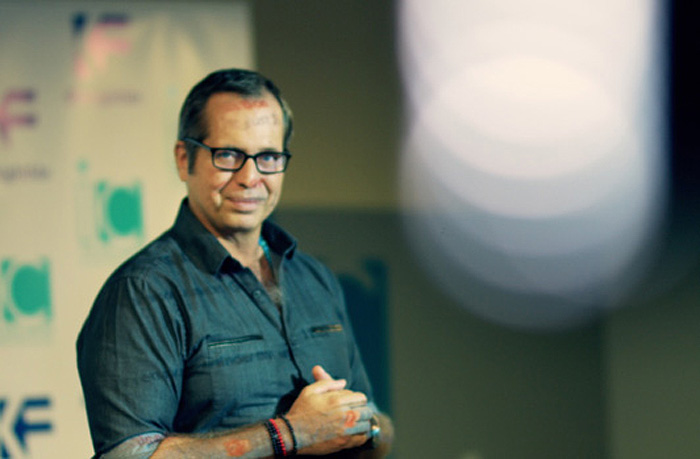 Alex de Carvalho, co-founder, Visual Storytelling Institute (photo by Ville Ailio)
Alex de Carvalho, co-founder, Visual Storytelling Institute (photo by Ville Ailio)
We swim in stories without knowing it, how to connect to them emotionally gives meaning to our lives.”
–Alex de Carvalho, co-founder, Visual Storytelling Institute
My partner in crime, Alex, did a phenomenal job covering why visual storytelling is so effective. He provided a comprehensive review of how two disciplines; visual media and storytelling converge in our brain for maximum impact. His tips offered our audience actionable advice on how to develop a sound visual storytelling strategy. I especially liked his tip, about showing the “backstage” of your story. Typically, that’s where the narrative is more interesting as you see how the story is developed including imperfections, vs. the iron out, finished product.
Snapchat: Respect the Ghost! Why Snapchat is the Ultimate Storytelling and Advertising Tool Available
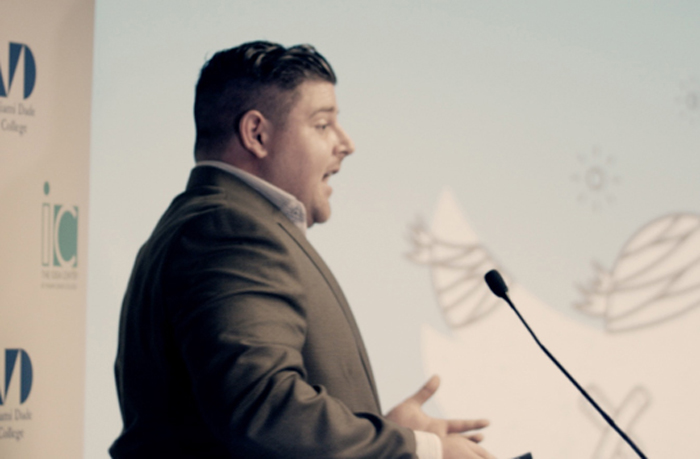 Brett Lindstrom, Lead Product Designer & Owner, CBS Sports & Lindstrom Creative
Brett Lindstrom, Lead Product Designer & Owner, CBS Sports & Lindstrom Creative
(photo by Ville Ailio)
Geo filters think of them as a campaign.”
–Brett Lindstrom, Lead Product Designer & Owner, CBS Sports & Lindstrom Creative
Brett provided a deep-dive review of Snapchat. He explored what Snapchat is, what it started out as, and what it will become. He also talked through how to create the right narrative for your brand, company or product. He also discussed key features how to use them properly and how to think about this technology from the ground up. His presentation literally captivated our audience as the topic is both hot and challenging to many, due to Snapchat’s less intuitive UI for older demographics. I really liked his presentation style that combined a value-added information delivered in a very entertaining way.
PR in the Age of Visual Storytelling
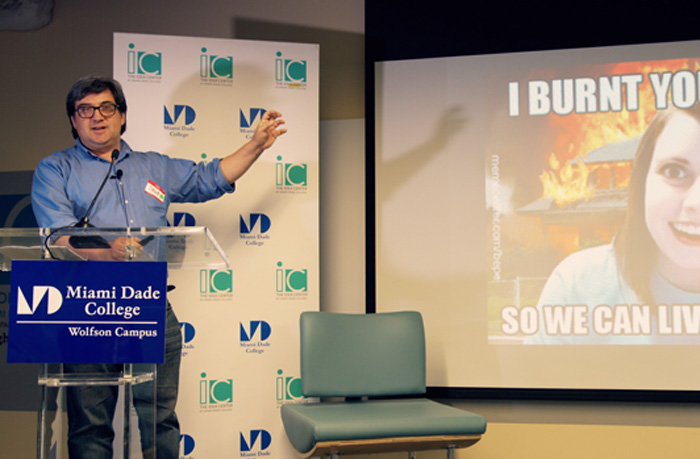 David Parmet, Owner, PR and Social Media Consultant, David Parmet Marketing & Public Relations
David Parmet, Owner, PR and Social Media Consultant, David Parmet Marketing & Public Relations
(photo by Ville Ailio)
Not enough PR people are using social media to pitch stories.”
– David Parmet, Owner, PR and Social Media Consultant, David Parmet Marketing & Public Relations
David a PR veteran, offered a fresh angle into a discipline that as he aptly said, “constantly reinventing itself.” The transition from the flat press release to cross-media experiences along with new ways of connecting with and engaging journalists through social media – brought a whole new set of perspectives. The Internet has changed how public relations does business. Now it’s no longer enough to send a press release or pitch email. Stories need to be illustrated using video and imagery to communicate. Public relations professionals need to become content creators, versed in the technology and skilled in creating compelling materials.
The Power of Visual Storytelling
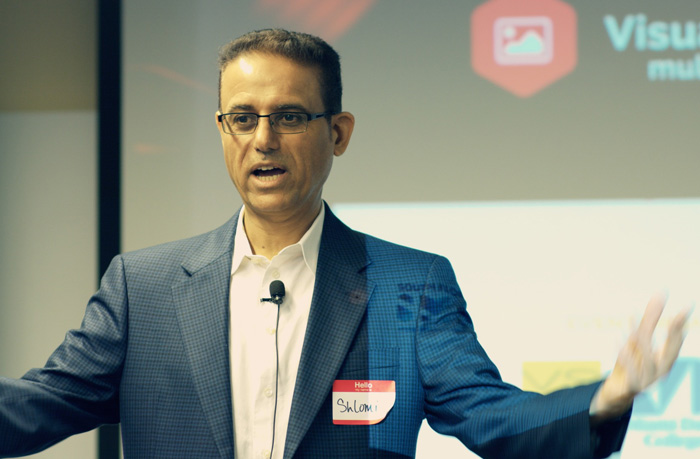 Shlomi Ron, co-founder, Visual Storytelling Institute (photo by Ville Ailio)
Shlomi Ron, co-founder, Visual Storytelling Institute (photo by Ville Ailio)
Do you remember when Content Marketing launched in 2005, but it wasn’t called Content Marketing? Visual Storytelling is the most important next step in effectively navigating the Visual Web.
–Shlomi Ron, co-founder, Visual Storytelling Institute
I provided our vision for visual storytelling. Some of it, is in the above introduction. The drivers for the current content explosion: Global Internet adoption, the emergence of social media and adoption of mobile devices. I also reviewed the evolution of storytelling frameworks from the early 1880’s to our homegrown 9-Step Visual Storytelling Framework. The visual storytelling examples, such as the 2013’s Dove Real Beauty Sketches’ campaign – helped our audience to see the principles I talked about come to life. Finally, I presented how the visual storytelling ecosystem looks like to paint a clear picture of the space and the opportunities it holds.
An Entrepreneur’s Journey
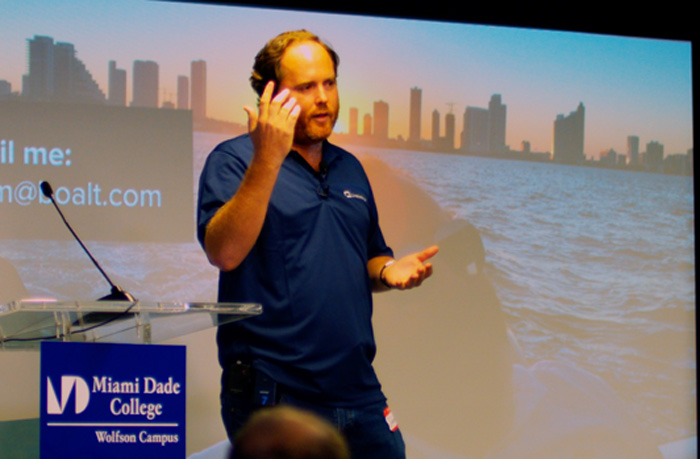 Adam Boalt, Founder, LiveAnswer (photo by Ville Ailio)
Adam Boalt, Founder, LiveAnswer (photo by Ville Ailio)
To do it right you need to dedicate 100% of yourself to your business.”
–Adam Boalt, Founder, LiveAnswer
We could not hope for a better way to seal our Summit experience with Adam’s inspiring entrepreneur’s journey. His “real talk” shed a clear light on the challenges any entrepreneur faces today without beautifying any element but showing things as they are – good or bad. From this perspective, his personal story demonstrated all the key ingredients we had talked about earlier in the day, for effective visual storytelling. It had a clear story arc (setup, conflict/s and resolution), the hero’s purpose was very clear (grow your company), the looming threats/dragons (I liked his stress meter and cash balance counter on every slide), and above all, he shared his business and personal vulnerabilities along the way – openly and candidly. These imperfections are what humanized his story and made our audience empathize with his message. Great lessons as most businesses today skip the conflict and just share their triumphs.
All in all, Summit validated the true hunger and viability of visual storytelling in empowering marketers and entrepreneurs. At the end of the day, we’re all storytellers and makers that are capable of controlling our narratives. It’s the right story and packaging that make all the difference.
Ready to unlock the power of visual storytelling and boost your marketing results? Schedule a conversation about your Visual Storytelling Workshop today!
Source: Visual Storytelling
September 28, 2016
The Role of Authenticity in Visual Storytelling

When you think about why authenticity plays such a critical role in delivering an impactful message, you can start by looking at the immediate meanings Merriam-Webster dictionary offers:
- Real or genuine: not copied or false
- True and accurate
- Made to be or look just like an original
What’s the first thing that comes to your mind looking at these definitions? If you said fake, phony, artificial – you’re on the right track. These are all adjectives that describe authenticity by using different categories of being untrue.
Authenticity in visual storytelling is one of the most loaded subjects you could imagine visual storytellers are grappling with today. Why? Think back about a recent movie, video clip you watched, or an image that moved you. What was the narrative element that triggered your emotions?
The magic typically happens when the visual story carries a good dose of vulnerability or imperfection that allows the audience to see the human aspects of your narrative and this way develop empathy and trust towards your message. A great example is Unilever’s seminal ‘Dove Real Beauty Sketches’ Viral Campaign of 2013:
This commercial garnered over 130M views and has several success ingredients at play here:
- Customer as the hero: Making the customer the hero of the story so you’re watching real stories by real people from their point of view, not the brand.
- Story duality: The story takes it one step further by revealing that the story people tell themselves about how they look is completely opposite to how other people see them. This is a great lesson for what I call the “double mirror effect.” The better the story you tell yourself, the better it makes you feel and then this effect spills outside to your external relationships and make your message more impactful.
- Make it relatable: By exposing the customer vulnerability/weakness and the element of surprise when contrasting with other people’s views, this helps show customers’ humanity, and trigger empathy.
- Make it believable: Once your story is able to generate empathy, it pushes viewers’ guards down (hey this is a commercial!), they start to identify with the message, see themselves in the story and this way help them trust the narrative core message.
- Bigger purpose: Throughout the video clip you don’t find even one mention or visual plug of the Dove product. Unilever identified a conceptual gap that is much larger than singing the attributes of their Dove soap. Their big WHY? Is really anchored on a simple message of “You’re more beautiful than you think.”
- Empowerment marketing: Unlike inadequacy marketing that uses fear to stage a need for a product, this video is all about human empowerment.
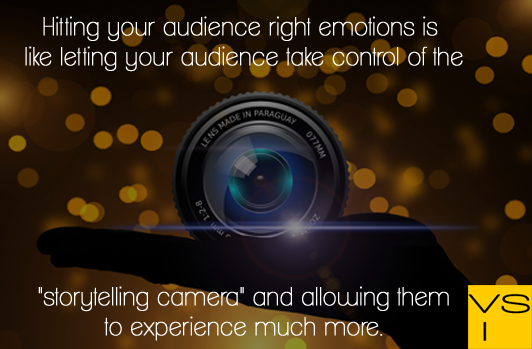
With Cisco projecting that 70% of the world mobile data by 2020 will be video, it has become imperative for marketers to figure out how to create effective video storytelling that will create that sought-after authentic brand experience to move audiences to action.
Ready to unlock the power of visual storytelling and boost your marketing results? Schedule a conversation with the Visual Storytelling Institute about your Visual Storytelling Workshop today!
This post originally appeared at Visual Storytelling Institute.
Source: Visual Storytelling
September 8, 2016
What is Visual Storytelling?
I am talking to a lot of folks these days about visual storytelling, and from these interactions, I learn that there is still a great deal of ambiguity about what is visual storytelling and why it’s important now for marketers? If you’re clueless too, don’t feel bad, some of the top dictionaries like Merriam-Webster and Oxford have no clue either:
Merriam-Webster:
Words fail us
Sorry, the word you’re looking for can’t be found in the dictionary.
Oxford:
No exact match found for “”visual storytelling”” in US English
When I figured, hey maybe these are old fashioned resources, let’s try Wikipedia, I received:
Visual narrative
A visual narrative (also visual storytelling) is a story told primarily through the use of visual media. The story may be told using still photography, illustration, or video, and can be enhanced with graphics, music, voice and other audio.
Getting warmer! The reality is that the term “Visual Storytelling” is pretty new. Looking at Google Trends, for the past 12 years the term garnered low counts of under 100 searches a month, and it’s only in the past 3 years that the term is experiencing a growth, albeit still modest.

Looking closer at these searches, we find that the term “Visual Storytelling” is largely associated with topics covering the visual arts targeting artists/designers: photography, media, illustration, and infographics.

Even though the traditional meaning of visual storytelling has been with us since the first man figured hey, I could create a stencil by blowing paint on my hand held to the wall to express how my day went. Sweet!
 Sulawesi Cave in Indonesia is the world’s first cave paintings 35,000 years ago.
Sulawesi Cave in Indonesia is the world’s first cave paintings 35,000 years ago.
BTW Text was invented only 32,00 years later!
After which, came the animal hunt stories – all the way to today’s visual arts such as photography, picture books, comics, video games, Instagram, Snapchat, Hollywood 3D movies and Virtual Reality.
In line with the term direct affinity with the entertainment industry, when I searched for “Visual Storytelling” definition the first result Google offered in their high-attention summary snippet was from EICAR – The International Film & Television School Paris:

It seems quite obvious that the term “visual storytelling” is quite new for both visual arts and more so in the context of marketing, so users have no reason to search for it just yet – think “content marketing” circa 2005. However, switching our camera lens to the marketing space in 2016, we find that marketers have realized that the benefits that rode visual storytelling in the entertainment space to new heights, also make a lot of sense when driving business impact with jaded audiences, overwhelmed by tons of copy cats content plays.
To paint the picture in broader strokes, we see that the communications landscape today is strongly marked by 2 opposing forces:
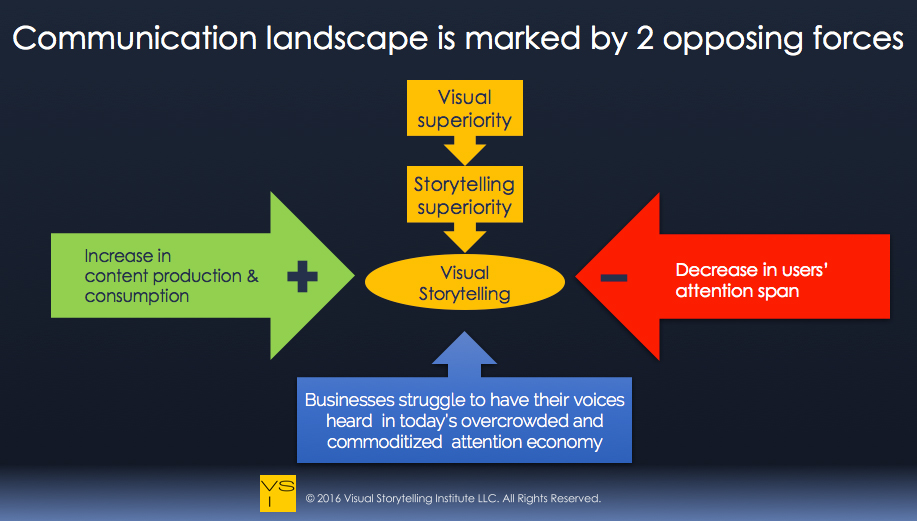
1) Content explosion: a dramatic and continual increase in content production,
> “4.6 billion pieces of content are produced every day” – LinkedIn
and content consumption is further enabled by greater broadband and mobile access
> 70% of the world mobile data traffic will be video by 2020” – Cisco
VERSUS
2) Decreased user attention span: a marked and well-documented downshift in focus
> The average human attention span is down to 8 seconds -Microsoft
We recognize 2 core drivers that support effective visual storytelling:
1. Our human brain processes visuals much faster than text
> “Visuals are processed 60,000 times faster than text by the human brain and 90% of information transmitted to the brain is visual” -3M
2. The human brain prefers information packaged as stories
> “92% of consumers want brands to make their ads feel like stories. -OneSpot
So what is the definition of visual storytelling
in the context of marketing?
Visual Storytelling is a marketing strategy that involves 3 conditions: 1) communicating ideas through 3-act story structure 2) placing your customer at the heart of the story and 3) delivering your story through immersive visual media – in order to create profitable customer engagements.”
– Shlomi Ron
That means that in order to cut through the clutter and resonate with your audience, as a marketer you need to put your audience as the hero of your story, addressing first their needs – not yours. Why? As Rolf Jensen aptly states, we’re entering the emotion-oriented “dream society” where customers take for granted the functionality of products and make purchase decisions based upon to what degree they believe a product will give them positive experiences (source: Storytelling Advertising – a Visual Marketing Analysis by Sarah Elise Väre).
Experience is key.
And companies that sell experiences, rather than product/service functions are poised to be rewarded with audience attention. A great example is Apple. Some of us own iPhone 6 devices that work perfectly fine, but regardless we gotta have the new iPhone 7, even with its marginal upgrade benefits. It’s that unique experience that the Apple story enables.
If you check Wikipedia under Storytelling, there is a whole section devoted to storytelling in business and marketing. Marketers use storytelling techniques because humans have an ingrained need to be entertained than being clobbered by dry product speeds and feeds.
With all the hype surrounding virtual reality (VR) these days, marketers need to mentally put on VR goggles and see the world through their customer’s eyes. It’s about introducing authentic narrative elements to illustrate a meaningful challenge your audience is facing and how you – as the brand marketer – can help them solve it with outcomes impacting both the business and personal levels.
Storytelling strategist, Kathy Klotz-Guest also suggests that such meaningful resolutions also need to carry social change that affects the environment, causes that are bigger than rational business results – the currency Millenials respond to the most. Warby Parker with their Buy a pair give a pair campaign or Patagonia that supports the environment – are good examples.
The magic happens only when your business story carries a good dose of vulnerability or imperfection that allows your audience to see the human aspects of your narrative and this way develop trust and empathy towards your message (i.e., mirroring themselves in your story). Why? Research suggests that when we read stories packed with distinct feelings, colors or odors, the same region in our brain is activated as if we would smell that particular odor or experience that feeling in real life.
How does the visual storytelling ecosystem look like?
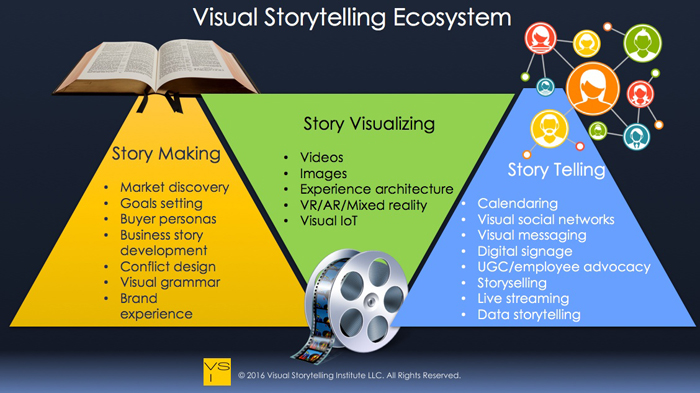
*Note: Behind each of the items listed above, there are complete sub-industries that offer either on-demand visual content management platforms or agency-side consulting.
Ready to unlock the power of visual storytelling and boost your marketing results? Schedule a conversation about your Visual Storytelling Workshop or one-on-one coaching today!
Source: Visual Storytelling